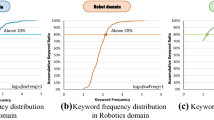Abstract
Theoretically, we first classified interdisciplinary research to three types: 1) creating new field from inside of the scientific community, 2) collaboration among disciplines lead by the societal needs outside of the scientific community, 3) making suggestions for public. For analysis on dynamics of knowledge combination in interdisciplinary research, we developed an indicator using “relative transmission” concept and also sub-domain maps using quantification factor analysis (1974). We used a sub-domain matrix, which show the structure of submitting crossing over several sub-domains from one individual. Using “researcher” as a unit of the analysis, we analyzed dynamics of the blends / separation of sub-domain in interdisciplinary studies. Biophysics and environmental science, which are categorized as 1) and 2) in the above theoretical types, are chose for analysis. The total numbers of researchers are 516 and 346, in each field respectively, and observation year points are 1966, 1972, 1979, and 1984 for biophysics and 1977 and 1983 for environmental science. The results showed that the structure of groups of sub-domains in environmental science reflects the classical disciplines and there observed little combination in the knowledge, whereas in biophysics, the sub-domains are not fixed and there observed dynamics in knowledge integration. These tendency are considered to reflect the characteristics of the type- 2) and type- 1), respectively.
Similar content being viewed by others
References
Callon M., Courtial, J-P., Turner, W. A., Bauin, S. (1983), From translation to problematic networks: An introduction to co-word analysis, Social Science Information, 22: 191-235.
Fujigaki, Y. (1996), Theoretical analysis on interdisciplinary collaboration as a base of UnIG collaboration: Knowledge based analysis, Proceedings of International Conference on Technology Management, pp. 206-211.
Fujigaki, Y. (1997), Theoretical framework and ongoing observation of knowledge integration in interdisciplinary collaboration: Intervention study on a project funded by a Japanese ministry, PICMET'97.
Fujigaki, Y., Nagata, A. (1998), Concept evolution in science and technology policy: The process of change in relationship among university, industry and government, Science and Public Policy, 26 (6):387-395.
Fujigaki, Y. (1998), Filling the gap between the discussion on science and scientist's everyday's activities: Applying the autopoiesis system theory to scientific knowledge, Social Science Information, 37 (1):5-22.
Fujigaki, Y., Leydesdorff, L. (2000), Quality control and validation boundaries in a Triple Helix of university-industry-government: “Mode 2” and the future of university research, Social Science Information, 39 (4):635-655.
Gibbons, M., LIMONGES, C., Nowotny, H., Schwartzman, S., Scott, P., TROW, M. (1994), The New Production of Knowledge: The Dynamics of Science and Research in Contemporary Societies London: Sage.
HayashI, T., Fujigaki, Y. (1999), Differences in the knowledge production between disciplines based on analysis of paper style and citation patterns, Scientometrics, 46 (1):73-86.
Hayashi, C. (1974), Methods for Quantifications, Toyo-Keizai-Shinpo.
Jantsch, E. (1972), Towards interdisciplinarity and transdisciplinarity in education and innovation, In: Interdisciplinarity, CERI.
Leydesdorff, L., Cozzens, S., Van Den Besselaar, P. (1994), Tracking areas of strategic importance using scientometric journal mappings, Research Policy, 23:217-229.
MiqueL, J. F., Okubo, Y. (1994), Structure of international collaboration in science, Scientometrics, 29 (2):271-297.
Peters, H. P. F., Van Raan, A. F. J. (1993), Co-word-based science maps of chemical engineering, Research Policy, 22: 47-71.
Seki, Ueda, Fujigaki, Nagano (1999) (in Japanese), The types of the process of scientists' problem formulation and the relationship with their backgrounds, Cognitive Science, 6 (4):419-431.
Shirabe, M., Fujigaki, Y. (2000), The introduction of economic methods to scientometrics: The citing-cited table and the autopoietic systems of citations, Scientometrics 47 (1):117-130.
Small, H. G. (1973), Co-citation in the scientific literature: A new measure of the relationship between two documents, Journal of the American Society for Information Sciences, 24:265-269.
Author information
Authors and Affiliations
Rights and permissions
About this article
Cite this article
Fujigaki, Y. Analysis on dynamics of research sub-domains in interdisciplinary fields: Analysis using personal distribution versus papers. Scientometrics 54, 63–74 (2002). https://doi.org/10.1023/A:1015632520964
Issue Date:
DOI: https://doi.org/10.1023/A:1015632520964




